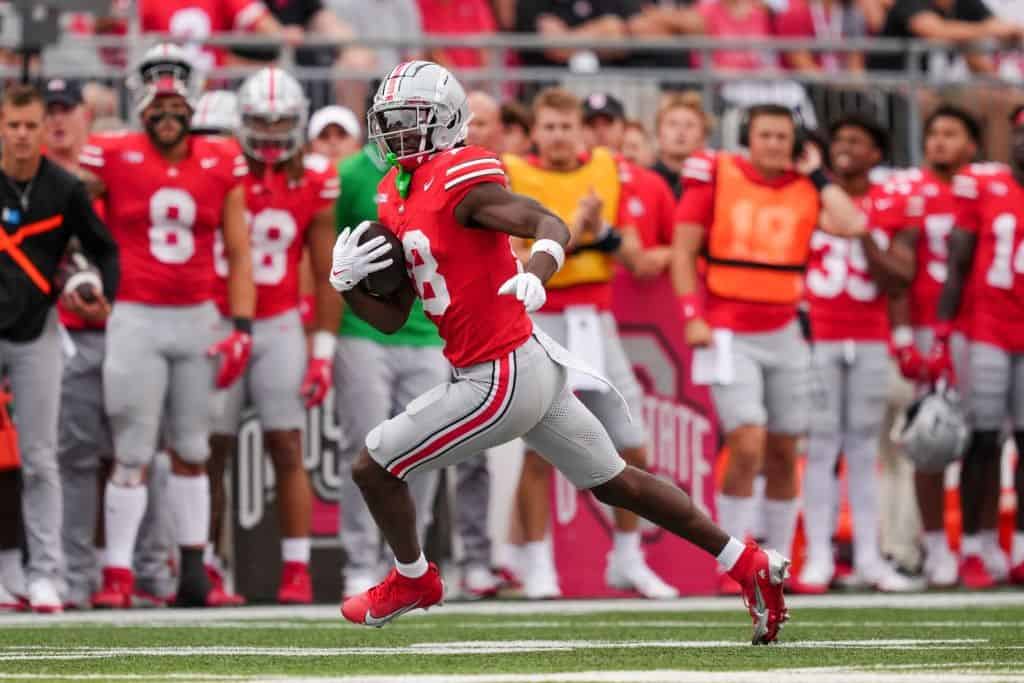We have already covered the quarterback, tight end, and running back rankings as we break down this incoming rookie class for Dynasty rookie drafts, startups, and even the potential these young players can have on the 2024 seasonal formats.
Even before the actual NFL Draft in April, rookies are available in Best Ball formats across all platforms.
Now that the NFL Combine has passed, we have a plethora of new athletic data on this upcoming rookie class. That information can be applied to athletic models and used to shape the full portfolio for prospects to go along with production profiles, which is a general overlay of what these players put on tape for NFL teams.
As we get more athletic testing data coming in via Pro Days, we will add notes here to those prospects.
However, overall, athletic testing has a low correlation to actual fantasy output. When it does, it is typically counted twice from a productive player in the first place.
But when a prospect has subpar athletic testing paired with a limited or nonexistent production resume, we are playing with fire when attempting to elevate or count on that player for NFL production.
Feel free to go back and check out the 2020, 2021, 2022, and 2023 versions of this article.
My ranks do not strictly follow my prospects models linearly.
I similarly use the prospect models as I do projection models for the NFL season. We are looking for immediate market inefficiencies in leagues where we are drafting rookies before the actual NFL draft.
This is an intriguing class set to provide an influx of talent at the position.
Overall, it is led by a triumvirate of front-end prospects who have as clean production profiles as you could ask for entering the league. We will immediately see all of the Tier 1 wide receivers in this class vault into WR1 consideration in Dynasty formats.
We will get into the volatility of this class along the way, but what makes this class so interesting is what comes after that initial group paired with a depressed draft season on the defensive side of the ball and at the running back position.
We are going to see a lot of wide receivers drafted in the top 100 picks this April.
This class has a lot more upside and pro arguments to make versus last year’s class.
That class did not have a wide receiver selected until pick No. 20 and had seven wide receivers selected in the top 60 picks.
This year, we should push to have three wide receivers selected inside of the top 10 while Mock Draft Database currently has 13 wide receivers in the top 60 sections.
Don’t miss out on the best fantasy football coverage in the business
Like the NFL, fantasy football never sleeps.
Best ball season is in full swing, and Dynasty rookie drafts will be here soon.
Sharp Football has everything you need to get ready for both in our Fantasy Football Draft Kit, powered by premier fantasy football analyst Rich Hribar.
Save more by bundling the Draft Kit with our in-season fantasy package that features Rich’s comprehensive “Worksheet” preview of every game, every week of the NFL season.
Click here for more information about our fantasy coverage!
Tier 1 Rookie Wide Receivers
This class has some major firepower at the top from a profile perspective.
All three of these wide receivers have grades in the 94th percentile or higher in my prospect model.
No wide receiver class in that database (going back to 2000) has had that many in the same year.
Early expectations are that all three of these wideouts will be selected in the top 10 picks of the draft.
I do have this as a 1A and 1B situation with Marvin Harrison and Malik Nabers with a clear No. 3 in Rome Odunze if we are talking about allocation of using rookie picks, but from a fantasy perspective, Odunze is far from drawing dead in terms of competing with other two.
Marvin Harrison Jr, Ohio State
Final Year Age: 21.4
Coming from premier NFL bloodlines at the position, Harrison Jr. posted back-to-back monster seasons at Ohio State, going for 1,295 yards and 14 touchdowns in 2022 and then coming back for 1,237 yards and 15 touchdowns this past season when he was the Biletnikoff Award Winner and a Heisman finalist.
Harrison accounted for 30.0% of the Ohio State targets (WR4 in this class among D1 players), 41.2% of their air yards (WR3), and 53.9% of their receiving touchdowns (WR1).
His 3.44 yards per route run were second to only Nabers while his 2.99 yards per team pass attempt ranked fifth.
Harrison was one of just five prospects in this draft class to average over 3.0 yards per route run against both man coverage (3.03) and zone coverage (3.51).
When defenses did play man coverage against Ohio State this season, Harrison was targeted on 40.0% of his routes, which was the highest rate in this class.
20.0% of Harrison’s career receptions were touchdowns, the highest rate in this class.
MARVIN HARRISON JR. WHAT A CATCH 😳
He has three touchdowns today
(via @BigTenNetwork)pic.twitter.com/lxTwvSW7Qn
— Bleacher Report (@BleacherReport) October 8, 2022
What is noteworthy about Harrison is that he came back and posted all of that efficiency after C.J. Stroud left.
While the Buckeyes have been on a strong of putting quarterbacks in the first round of the NFL Draft, Harrison was excellent playing attached to Kyle McCord. McCord ranked 62nd in passing grade at Pro Football Focus in 2023 and transferred to Syracuse this spring when he was not guaranteed the starting gig in 2024.
The other two wideouts in this tier fared far better in quarterback attachment this past season as Jayden Daniels was third in passing grade and Michael Penix was ninth.
Harrison also has next to zero manufactured production in his profile.
Only 7.0% of his targets were behind the line of scrimmage (26th in this class).
I view that as an overall positive, but this is the one area where Harrison draws the small amount of criticism he does when picking nits.
Harrison checked in at 6-foot-3 and 209 pounds at the NFL Combine, but he did not participate in any physical testing.
Where Harrison is slightly dinged in scouting is tearing down his long speed and yards after the catch ability, which Nabers has in spades.
Harrison forced a missed tackle on just 7.5% of his receptions in 2023 (31st in the class).
26.3% of his targets in 2023 were contested catches, which was the fifth-highest rate in this class.
Despite that, Harrison did make strides after the catch in 2023 versus 2022. He averaged 6.4 yards after the catch this past season (WR14 in this class) after 4.2 yards after the reception per grab in 2022.
Although Nabers did a lot more in terms of forcing missed tackles, Harrison still did have 35.3% of his yardage in 2023 come after the reception, which was not far away from Nabers (37.6%).
I also believe Harrison is capable of doing more in terms of versatility in the NFL. He just was not asked to do a lot of it in this Ohio State offense.
I do not believe that is overly different from where people tore down Stroud’s ability to play off-script entering the league based on the limited sample of pressure he faced within the structure of this offense.
When Ohio State did task Harrison to win in unique ways, he completely dominated.
He only ran 19.3% of his routes from the slot last season, 24th in this class. But when Harrison did work from the inside out, he was targeted on 42.7% of those routes (WR2 in this class) and averaged a class-high 5.22 yards per route run from the slot.
If an NFL team wants to move Harrison around, I have next to no fear that he can win there.
I do have Harrison slightly ahead of Nabers based on a projection that he will be the first wide receiver taken in April.
If Harrison does end up going No. 4 overall to Arizona, that is an ideal landing spot for immediate production paired with a capable quarterback and a turnstile opportunity to lead the team in targets in Year 1.
The rest of the landing spots in the top 10 leave a lot more immediate question marks at quarterback (the Giants or Patriots if they pass on a quarterback) or playing alongside another WR1 (Atlanta, Chicago, and the Jets).
The Chargers are certainly a wild card component for teams not trading up, however. They have a front-end quarterback and no established receivers with Keenan Allen and Mike Williams gone.
We will revisit these top two wideouts post-draft and see where things shook out.
Malik Nabers, LSU
Final Year Age: 20.5
Nabers and Harrison are extremely close and both elite prospects.
We have seen these two compared to the year that A.J. Green and Julio Jones came into the league.
Nabers does not have multiple elite collegiate seasons (his 2022 was good but not as great) as Harrison does, but he is right in line with him in immediate projection.
The primary reason I do not have any beef having Nabers higher is that he already was used the way that the top receivers are winning in the NFL versus the current defensive meta.
If you look at the top receivers in production (which leads to fantasy points), we are no longer seeing the prototypical X receiver from yesteryear at the front of the leaderboards. We are seeing players that can win everywhere in all alignments.
Defenses are playing man coverage at an all-time low paired with more two-high coverage.
NFL offenses are forced to attack the middle of the field more than ever with the current approach to the game.
It is no surprise that we are seeing guys like CeeDee Lamb, Amon-Ra St. Brown, and Tyreek Hill crushing.
In 2023, 19 wide receivers averaged at least 15.0 PPR points per game.
The average slot rate for those wideouts was 28.9%. Only five of those 19 were below 20% while six of them were over 30%.
Even a player like Ja’Marr Chase logged a career-high 24.8% slot rate in 2023.
We had two rookies (Puka Nacua and Tank Dell) on that list that won that way in college.
The bottom line is that getting the football to your best wide receiver takes more game planning and diverse usage than ever before.
I believe Harrison will be able to win inside in the NFL, but he does take projection whereas Nabers did a lot of everything in the LSU offense.
From a top-down perspective, Nabers averaged a class-high 3.64 yards per route run and 3.81 yards per team pass attempt.
Nabers was second in this class among D1 prospects in target share (32.5%) and third in the share of receptions (31.1%) while playing alongside another wide receiver projected to be selected in the first round of this draft.
Nabers forced a missed tackle on 33.7% of his receptions (second in this class) while averaging 6.6 yards after the catch per reception (WR9).
Malik Nabers loop YAC pic.twitter.com/FZZ9EhuK4L
— JetPack Galileo (@JetPackGalileo) March 11, 2024
He ran 52.9% of his routes from the slot, where he caught a class-high 12 touchdowns and averaged 4.35 yards per route run (third in this class).
He averaged 3.22 yards per route run against man coverage (WR7) and a class-high 4.42 yards per route against zone coverage.
Although Nabers did have access to more slot routes in college than Harrison did, do not make the mistake he was stacking output on free squares.
He only had 14 targets on screens. That 10.9% share of his season total was WR19 in this class.
Nabers had nine touchdowns on throws over 20 yards downfield, which was second in this class behind teammate Brian Thomas.
When tasked with clashing, Nabers caught 10-of-22 contested catches (45.6%) compared to Harrison snagging 13-of-30 (43.3%).
To top that all off, Nabers is the youngest wide receiver available in the draft.
He will not turn 21 years old until late July.
Nabers declined to do anything physically at the NFL Combine, but at his Pro Day, he checked in at 6-feet and 199 pounds.
He ran a 4.35 unofficial time in the 40-yard dash while logging a 94th-percentile explosion score in jumping drills.
Rome Odunze, Washington
Final Year Age: 21.6
In several previous seasons, Odunze would have been the clear WR1 in the class.
Odunze got better all four years at Washington, capped by a 2023 season in which he caught 92 balls for 1,640 yards and 13 touchdowns, adding a rushing score for good measure.
Odunze’s 81.8 receiving yards per game over his college career rank first in this draft class among Division 1 prospects.
He played alongside two other wide receivers projected to be selected in this draft, still accounting for 26.2% of his team targets (WR8).
His 2.85 yards per team pass attempt was seventh in this draft class.
Odunze shredded man coverage for 3.75 yards per route run (third in this class) paired with 2.93 yards per route against zone (WR10).
Odunze is arguably the best vertical wide receiver between the three we have covered at the top, which is saying something.
Nobody in this class flashes “late hands” like he does.
Odunze can get open on his route-running ability, but he dominated when asked to win in contested situations despite not being forced to live on contested catches alone.
20.0% of his targets were contested catches in 2023, below the 26.3% rate for Harrison and above Nabers (17.2%).
On those contested targets, Odunze caught a staggering 21-of-28 (75.0%).
😱😱😱
⬆️ us after that catch.
Rome Odunze’s one-handed TD snag earns Catch of the Week.#GoHuskies | @UW_Football | @PacificSeafood pic.twitter.com/f0m6dVwakI
— Pac-12 Network (@Pac12Network) November 30, 2021
35.0% of Odunze’s targets came on throws 20 or more yards downfield, which was the fourth-highest rate in this class.
He had 15 more downfield targets than the next closest wide receiver in this class.
He played in the slot at a lower rate of his routes (17.5%) than both Harrison and Nabers did in college, but Odunze had more created production despite winning downfield more than the others.
19.6% of his receptions were screens compared to 15.7% for Nabers and 11.9% for Harrison.
Despite that, only 31.4% of Odunze’s yards came after the catch compared to 35.3% for Harrison and 37.6% for Nabers because he drew so many downfield targets.
His 2.58 yards per route run from the slot (WR14 in this class) were far off from the destruction that both Harrison (5.22 YRR) and Nabers (4.35 YRR) posted when given those opportunities.
All of that put together puts Odunze in a bucket of having more projection in winning everywhere in the NFL than the previous two, but he has true spades to start with.
Unlike both Harrison and Nabers, Odunze did physical testing at the NFL Combine and came out checking all of the boxes we wanted.
Coming in at 6-foot-2 and 212 pounds, he was one of the few receivers to participate in every drill, running a 4.45 forty (84th percentile speed score) while registering a 78th percentile explosion score in jumping drills and a 94th agility score.
Tier 2 Rookie Wide Receivers
Things are not as clean here as the first three wideouts, but all three of these next wide receivers have both strong production and physical profiles. There is a reason that all of them are projected to be selected with strong draft capital.
That said, this is an immediate tier drop.
There are also enough red flags here to make me pause in using a first-round pick in rookie drafts.
If I am on the clock and staring one of these wideouts down as the best player available, I would prefer to move down and take multiple swings on the depth of this class.
But we also should see a few of these guys land in ideal situations in the NFL, which could give them attachment to good quarterback play right out of the box.
Brian Thomas Jr, LSU
Final Year Age: 21.2
After catching 59 passes for 720 yards and seven touchdowns over his first two seasons at LSU, Thomas erupted in 2023 with 68 receptions for 1,177 yards and 17 touchdowns.
Stuck behind Kayshon Boutte for those opening two seasons, Thomas is leaning on his gaudy 2023 campaign to carry his production profile.
53.5% of his catches, 62.1% of his yards, and 70.8% of his touchdowns came in his final season, rates that rank fourth, second, and second in this class.
With just one monster season on his resume, Thomas does draw some odder comparables as his top hits. Players such as Torrey Smith, Freddie Mitchell, and Jameson Williams are at the top of his hit list.
Thomas played with the Heisman Winner and alongside an all-world wideout that allowed Thomas to excel, which does at least place some trepidation that his 2023 was lightning in a bottle.
Nabers took all of the creative usage in this offense last season, which allowed Thomas to eat on the outside and downfield.
Thomas was only targeted on 19.3% of his routes, which was 34th in this draft class.
Only 13.3% of the routes that Thomas ran came from the slot, 30th in this class.
68.2% of the receptions Thomas had were on throws 20 or more yards downfield, fourth in this class.
He led all of college football with 12 touchdowns on throws 20 or more yards downfield.
He also led all of college football last season in yardage (577) and touchdowns (13) gained on only go, post, and fade routes per Sports Into Solutions.
We are still looking for more body of work that Thomas can win everywhere on the field, but the overall package is alluring.
Thomas is a former four-star recruit who had offers to Alabama, Florida, and Auburn. He was heavily recruited.
He also has a physical profile that teams will pursue and reinforces his downfield production at the college level.
At 6-foot-2 and 209 pounds, Thomas ran a 4.33 40-yard dash at the NFL Combine. He also posted an 82nd-percentile explosion score in the jumping drills.
Troy Franklin, Oregon
Final Year Age: 20.9
Franklin made consistent jumps in production over his three seasons at Oregon, closing out this past season with 81 catches for 1,383 yards and 14 touchdowns.
To continue reading this article
and gain access to all of Rich Hribar's industry leading content both before and during the season, click below to purchase our fantasy football bundle.
Purchase
















